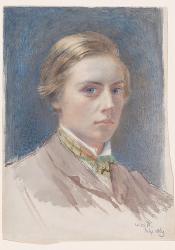William Blake Becomes an Apprentice as an Engraver
Most of William Blake’s poetry was printed by the man himself. William Blake apprenticed under Jame Basire, “...one of the most successful engravers of all time.” (Bently 1) During this time Blake had mastered the traditional form of engraved printing. He became extremely proficient in printing and gained a reputation in the community for it. However, after his apprenticeship Blake began to experiment with different types of reproduction techniques. After taking advice and working with techniques of his colleagues he created a revised version of engraving that was later known as “Illuminated Printing”. Blakes new method of printing was a reversal of the traditional way of printing. In a method known as “Mirror Printing”, which is when the words would be written backwards so that way when they were pressed upon a page, it would come out in the right direction. Mirror Printing was a method taught to almost all apprentices at the time. However, Blake’s reinvention of it was masterful and allowed for faster printing that costs less. Blake also found work in color printing. He would be able to use other colors aside from black. Colors like blue, green, brown, and red. It is also said that Blake was able to create a multi-color printing method that, to this day, is still being studied by historians as to how he did it. The amazing part about William Blake’s mastery of printing was that he used it to print his own work. This was often an issue of concern for writers in the time. Although someone could be literate enough to write poetry and articles, they would be in need of a way to get that information printed. William Blake wrote knowing that his writing would be printed in his own shop. He would immediately be able to publish his own works after they had been written. The significance of Blake being able to have such easy access to printing was that he was able to write in confidence of when the text would be available. Even to this day, when a text is written to be printed on paper, authors are not always aware of when their text will be available to the public. There is no saying if Blake’s understanding of printing led to his desire for writing, however it can be assumed that it made a major impact on ability to publish and print once he decided to write. As previously stated, Blake was able to use his new techniques to attract readers with his form of engraving. His words would stand out in sharper lines and with the use of color, he could add details that would not be common in most books. In the modern day we remember William Blake for his powerful poetry and his endless discourses on nature's relationship with the human soul. But Blake’s contributions to engraving and printing could be argued to have a similar impact to his image as a writer. His mastery of the printing press led to the publication of texts that would influence readers to this day. Bentley, G. E. “William Blake’s Techniques of Engraving and Printing.” Studies in Bibliography, vol. 34, Bibliographical Society of the University of Virginia, 1981, pp. 241–53, http://www.jstor.org/stable/40371744.

